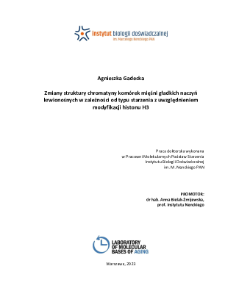
Object
Title: Zmiany struktury chromatyny komórek mięśni gładkich naczyń krwionośnych w zależności od typu starzenia z uwzględnieniem modyfikacji histonu H3 : praca doktorska
Institutional creator:
Instytut Biologii Doświadczalnej im. Marcelego Nenckiego PAN
Contributor:
Bielak-Żmijewska, Anna (1966- ) : Supervisor
Publisher:
Instytut Biologii Doświadczalnej im. Marcelego Nenckiego PAN
Place of publishing:
Description:
213 pages : illustrations ; 30 cm ; Bibliography ; Summary in English
Degree grantor:
Instytut Biologii Doświadczalnej im. Marcelego Nenckiego PAN
Type of object:
Abstract:
The average life expectancy of the human population continues to rise, resulting in aging societies. However, this demographic shift brings a concerning increase in the prevalence of age-related diseases, particularly cardiovascular diseases. According to the World Health Organization (WHO), cardiovascular diseases remain the primary cause of death globally. The most common include hypertension, heart attack, aortic aneurysm, and stroke. At the core of these conditions lies development of atherosclerosis – an inflammatory disease of the arteries that leads to the narrowing of vessel lumen through the formation of stable or unstable (posing greater health risk) atherosclerotic plaque (AP). Multiple studies have identified vascular smooth muscle cells (VSMCs) as one of the critical cell types essential for proper vascular function and AP stability. VSMCs derived from atherosclerotic plaques, exhibit numerous characteristics associated with cellular senescence. Cellular senescence is defined as an irreversible cell cycle arrest with preservation of full, albeit altered, metabolic functions. It can arise due to either exhaustion of replication potential (replicative senescence - RS) or exposure to various stressors (premature senescence - PS). Regardless of the trigger, both types of cellular senescence cause several morphological changes, particularly at the nuclear and gene expression level. These changes involve gradual loss of compact heterochromatin, and the formation of relaxed euchromatin. Several factors contribute to this transformation, including loss of histones, imbalances in the post-translational modifications of histones, disruptions in histone-remodeling enzymes, and alterations in proteins that stabilize chromatin structure. One such protein is HP1α (Heterochromatin Protein 1 subunit α), which, by attaching to trimethylated lysine 9 of histone 3 (H3K9me3), causes chromatin condensation, stabilization and gene silencing. Preliminary studies conducted at the Laboratory of Molecular Basis of Aging revealed a significant decrease in both H3K9me3 and HP1α protein levels during senescence and reorganization of HP1α, which forms pronounced clusters. Therefore, the main objective of this dissertation was to analyze changes in selected histone H3 modifications and their impact on chromatin structure and gene expression in senescent VSMC, fibroblasts and cells derived from atherosclerotic plaque. The second goal was to clarify the involvement of HP1α in the process. VSMCs were subjected to both replicative and premature senescence, where premature senescence was induced by doxorubicin and curcumin. This experimental framework was extended to fibroblasts, while smooth muscle cells isolated from atherosclerotic plaques were analyzed from at least six patients. The comprehensive analysis of nucleus and chromatin structure in senescent VSMCs revealed significant changes, differentiating RS from PS. One of the differentiating parameters, nuclear surface area size specific to VSMCs, helped to identify senescent cells in a population derived from atherosclerotic plaque. Furthermore, it has been demonstrated that the decline in H3K4me3, H3K9me3, H3K27me3, and H3K9Ac modifications is a universal hallmark of senescence across tested types of cells, although the level of decrease is different in PS and RS. The level of tested modifications in the ex vivo model was heavily dependent on the donor. The decrease and reorganization of HP1α in senescence prevented interaction with H3K9me3, probably due to accumulation of HP1α in PML bodies. Based on ChIP-seq data, the characteristic sites of H3K9me3 and HP1α interactions in young VSMC were selected. In addition, it was shown that VSMCs assume different distribution of H3K4me3 and H3K9me3 in the genome that depends on the type of senescence.
Detailed Resource Type:
Resource Identifier:
Source:
Language:
Language of abstract:
Digitizing institution:
Nencki Institute of Experimental Biology of the Polish Academy of Sciences
Original in:
Library of the Nencki Institute of Experimental Biology PAS
Projects co-financed by:
Access:
Object collections:
- Digital Repository of Scientific Institutes > Partners' collections > Nencki Institute of Experimental Biology PAS
- Digital Repository of Scientific Institutes > Partners' collections > Nencki Institute of Experimental Biology PAS > Dissertations > PhD Thesis
- Digital Repository of Scientific Institutes > Literature
- Digital Repository of Scientific Institutes > Literature > Thesis
Last modified:
Feb 27, 2024
In our library since:
Feb 27, 2024
Number of object content downloads / hits:
200
All available object's versions:
https://rcin.org.pl/publication/276923
Show description in RDF format:
Show description in RDFa format:
Show description in OAI-PMH format:
Objects Similar
Głuchowska, Agata
Grabowska, Agnieszka Kamila

 INSTYTUT ARCHEOLOGII I ETNOLOGII POLSKIEJ AKADEMII NAUK
INSTYTUT ARCHEOLOGII I ETNOLOGII POLSKIEJ AKADEMII NAUK
 INSTYTUT BADAŃ LITERACKICH POLSKIEJ AKADEMII NAUK
INSTYTUT BADAŃ LITERACKICH POLSKIEJ AKADEMII NAUK
 INSTYTUT BADAWCZY LEŚNICTWA
INSTYTUT BADAWCZY LEŚNICTWA
 INSTYTUT BIOLOGII DOŚWIADCZALNEJ IM. MARCELEGO NENCKIEGO POLSKIEJ AKADEMII NAUK
INSTYTUT BIOLOGII DOŚWIADCZALNEJ IM. MARCELEGO NENCKIEGO POLSKIEJ AKADEMII NAUK
 INSTYTUT BIOLOGII SSAKÓW POLSKIEJ AKADEMII NAUK
INSTYTUT BIOLOGII SSAKÓW POLSKIEJ AKADEMII NAUK
 INSTYTUT CHEMII FIZYCZNEJ PAN
INSTYTUT CHEMII FIZYCZNEJ PAN
 INSTYTUT CHEMII ORGANICZNEJ PAN
INSTYTUT CHEMII ORGANICZNEJ PAN
 INSTYTUT FILOZOFII I SOCJOLOGII PAN
INSTYTUT FILOZOFII I SOCJOLOGII PAN
 INSTYTUT GEOGRAFII I PRZESTRZENNEGO ZAGOSPODAROWANIA PAN
INSTYTUT GEOGRAFII I PRZESTRZENNEGO ZAGOSPODAROWANIA PAN
 INSTYTUT HISTORII im. TADEUSZA MANTEUFFLA POLSKIEJ AKADEMII NAUK
INSTYTUT HISTORII im. TADEUSZA MANTEUFFLA POLSKIEJ AKADEMII NAUK
 INSTYTUT JĘZYKA POLSKIEGO POLSKIEJ AKADEMII NAUK
INSTYTUT JĘZYKA POLSKIEGO POLSKIEJ AKADEMII NAUK
 INSTYTUT MATEMATYCZNY PAN
INSTYTUT MATEMATYCZNY PAN
 INSTYTUT MEDYCYNY DOŚWIADCZALNEJ I KLINICZNEJ IM.MIROSŁAWA MOSSAKOWSKIEGO POLSKIEJ AKADEMII NAUK
INSTYTUT MEDYCYNY DOŚWIADCZALNEJ I KLINICZNEJ IM.MIROSŁAWA MOSSAKOWSKIEGO POLSKIEJ AKADEMII NAUK
 INSTYTUT PODSTAWOWYCH PROBLEMÓW TECHNIKI PAN
INSTYTUT PODSTAWOWYCH PROBLEMÓW TECHNIKI PAN
 INSTYTUT SLAWISTYKI PAN
INSTYTUT SLAWISTYKI PAN
 SIEĆ BADAWCZA ŁUKASIEWICZ - INSTYTUT TECHNOLOGII MATERIAŁÓW ELEKTRONICZNYCH
SIEĆ BADAWCZA ŁUKASIEWICZ - INSTYTUT TECHNOLOGII MATERIAŁÓW ELEKTRONICZNYCH
 MUZEUM I INSTYTUT ZOOLOGII POLSKIEJ AKADEMII NAUK
MUZEUM I INSTYTUT ZOOLOGII POLSKIEJ AKADEMII NAUK
 INSTYTUT BADAŃ SYSTEMOWYCH PAN
INSTYTUT BADAŃ SYSTEMOWYCH PAN
 INSTYTUT BOTANIKI IM. WŁADYSŁAWA SZAFERA POLSKIEJ AKADEMII NAUK
INSTYTUT BOTANIKI IM. WŁADYSŁAWA SZAFERA POLSKIEJ AKADEMII NAUK


































